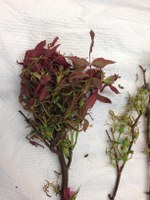Dakota Gardener: Protect Your Plants From Rose Rosette Disease
(Click an image below to view a high-resolution image that can be downloaded)
By Esther McGinnis, Horticulturist
NDSU Extension
While the human population grapples with a devastating virus, the rose community also is combating a widespread disease.
Rose rosette disease has caused more than $50 million in losses in the U.S. First reported in 1940, its viral cause was not discovered until 2011. The disease has been documented in Minnesota and North Dakota.
When I tell people that plants can be infected with a virus, they are incredulous. However, tobacco mosaic virus, the first virus to be identified as a pathogen in the 1930s, was discovered in plants.
Microscopic mites vector the rose rosette virus to susceptible rose shrubs. These pesky mites ride the wind currents to float to an adjacent rose shrub in the garden and spread the virus.
Unfortunately, the virus initially can escape detection because the symptoms mimic other things. One of the most commonly reported symptoms is excessive reddening of the leaves. However, new growth on healthy rose shrubs may be red, so this symptom is not conclusive.
A second common symptom is the development of witches’ brooms. Witches’ brooms are the abnormal proliferation of leaves or shoots in an area. Herbicide injury also can cause the production of witches’ brooms on roses but usually does not involve excessive red pigmentation.
Other symptoms of the virus include excessive stem length, increased thorniness on stems and a large stem that originates from a smaller stem. Leaves may be unusually small and distorted. Symptoms may differ depending upon the cultivar.
Most cultivated roses appear to be susceptible. Prairie rose, the North Dakota state flower, appears to be resistant. Rose breeders around the country are attempting to breed resistant roses and millions of dollars have been allocated to research this disease.
The disease is not curable and is eventually fatal in two to three years. Rose collectors should be extra careful in buying new roses because the disease spreads through the nursery trade. Choose healthy-looking shrubs and avoid purchasing from nurseries that appear to have diseased shrubs.
When planting rose shrubs, put extra space between them to prevent the mites from spreading from shrub to shrub. For rose collectors, be vigilant in scouting for the disease. Your local Extension agent can help you with diagnosis if you are unsure of the symptoms.
If you have lost roses to this disease in previous years, researchers recommend protecting healthy rose shrubs by cutting rose stems back by two-thirds in late winter to depress mite populations that may overwinter. An application of a horticultural oil at that time may smother mite eggs.
Once the disease has been detected on a rose shrub, you must dig up the entire plant and the root system because the disease is systemic in the plant. Carefully place the shrub in a plastic bag to prevent the mites from dropping off the infected plant and dispose of it. Research has shown that careful scouting and “roguing” (identifying and removing plants with undesirable characteristics) of infected plants can be effective even in large botanical gardens.
For more information about gardening, contact your local NDSU Extension agent. Find the Extension office for your county at https://www.ag.ndsu.edu/extension/directory/counties.
NDSU Agriculture Communication - Aug. 18, 2020
| Source: | Esther McGinnis, 701-231-7971, esther.mcginnis@ndsu.edu |
|---|---|
| Editor: | Ellen Crawford, 701-231-5391, ellen.crawford@ndsu.edu |




